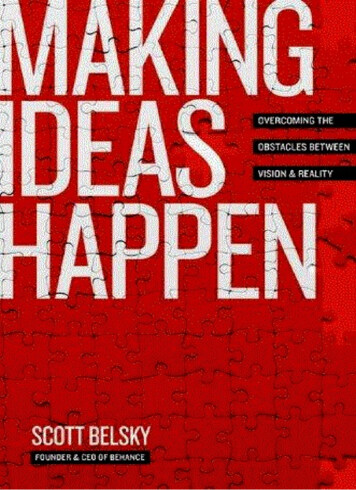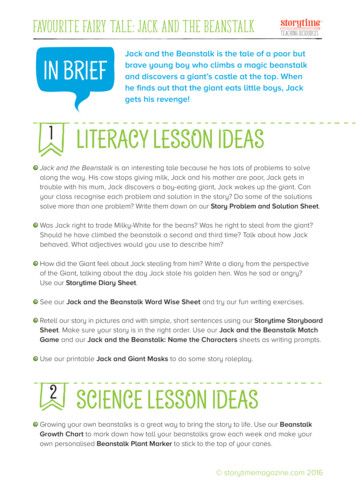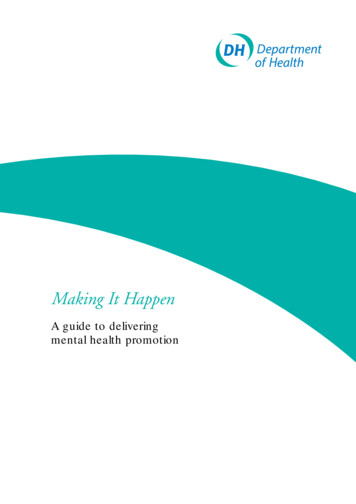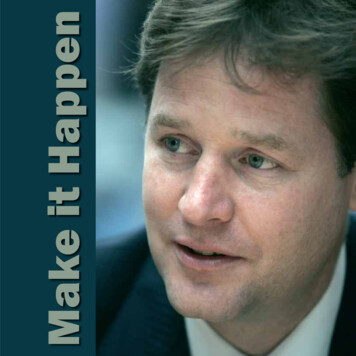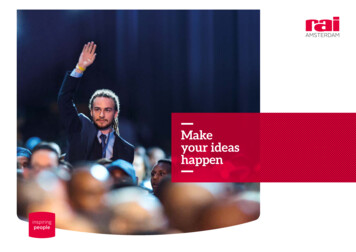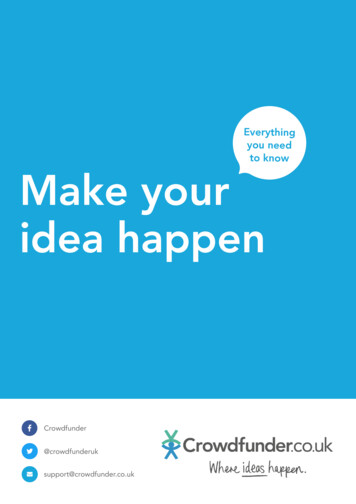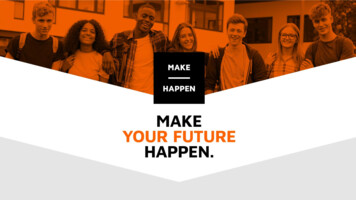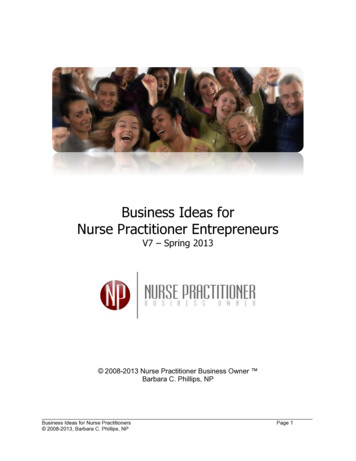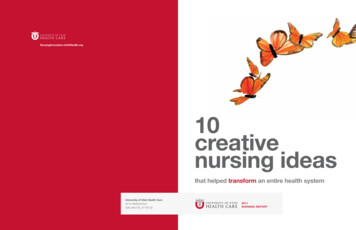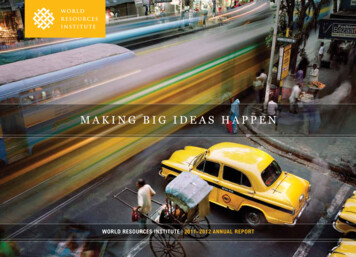
Transcription
Making Big Ideas Happenworld resources institute 2011–2012 Annual Report
2 Making Big Ideas HappenOur mission is to move human societyto live in ways that protect Earth’senvironment and its capacity to providefor the needs and aspirations ofcurrent and future generations.on THE COVER Kolkata, India from the series “Metropolis,” 2008 by Dutch photographer Martin Roemers. Roemers’ Metropolis series underscoresthe critical need to steer the force of rapid global urbanization in ways that improve people’s lives and reduce pressure on Earth’s scarce resources.
world resources institute 2 0 1 1 – 2 0 1 2 A n n u a l R e p o r tMaking Big Ideas Happen2011/2012 was a transition period as WRI said goodbye to President Jonathan Lash andwelcomed new President Andrew Steer. With ample wind in our sails from eighteen yearsof Jonathan’s leadership, the Institute’s accomplishments—many captured in this report—reflect both the strength and versatility he instilled in the organization.The energetic collaboration among a highly motivated leadership team, staff and Boardof Directors yielded strong results. WRI experienced its sixth consecutive year of growth,with a 12 percent increase in its budget in 2011. We expanded our China office and signed amemorandum of understanding with NDRC, China’s main planning agency, to work togetheron low carbon city development and related issues. We took the seminal step in India ofestablishing a trust and a distinguished board chaired by WRI Director Jamshyd Godrej.WRI will invest considerable effort over the next five years working at the city level in China,India and Brazil on sustainable transportation and road safety, renewable energy and cleanwater. As centers of intellectual capital, talent, and entrepreneurship, cities are proving to be atthe vanguard in tackling global climate change and a broader array of sustainability challenges.Our commitment to protecting the environment and improving people’s lives remains asstrong as ever. The combined stress of rising and volatile commodity prices, ecosystemdegradation, and global warming disproportionately affects poor and vulnerablecommunities, who rely on natural resources for their livelihoods and well-being. WRI willredouble its efforts to make the economic case and demonstrate through its work thatsustainability and poverty reduction—and more broadly economic growth—go hand-in-hand.The challenges facing the planet and people are epic in proportion. WRI was founded topursue big ideas and make them happen. We remain optimistic that our efforts, amplifiedwith hundreds of worldwide partners, are shaping a more sustainable planet for all people.James A. HarmonChairman of the BoardAndrew SteerPresident and CEOManish BapnaInterim President(May 2011 – July 2012)Managing Director1
2 Making Big Ideas HappenO u r Pr o g r a m s , A p p r o a ch , a n d E n g a g e m e n tWRI’s work is organizedaround five programs,each of which hassupporting five-yearobjectives and multipleprojects. In addition,we are exploring anew program on cities,which would link oursustainable transportprogram with a growingbody of work aroundurban sustainabilityfocused on China, India,and Brazil.ProgramsValuesC l i m a t e e n e r g y Protectthe global climate system from further harmdue to emissions of greenhouse gases and helphumanity and the natural world adaptto unavoidable climate change.Our values define WRI as an institution. Our valuesGO V E R NAN C E Acc e s s Empowerpeople and strengthen institutions to fosterenvironmentally sound and socially equitabledecision-making.M A R KETS ENTE R P R ISE Harnessmarkets and enterprise to expand economicopportunity and protect the environment.PEOPLE E C OSYSTE M S Reverse rapiddegradation of ecosystems and assure their capacityto provide humans with needed goodsand services.S u s t a i n a b l e Tr a n s p o r t Improvethe quality of life in cities by catalyzing and helpingto implement sustainable transport solutions.are not rules, but shared ideals and understandingthat bind us together. Along with our mission andour commitment to excellence in everything we do,they articulate who we are and what we believe,influence our work, guide our actions, and help usto explain our aspirations to others.1) Integrity2) Innovation3) Urgency4) Independence5) Respect
Programs, Approach, and Engagement 2 0 1 1 – 2 0 1 2 A n n u a l R e p o r tW R I E n g a g e m e n t Acr o s s t h e W o r l dCOUNTRYOFFICEPLANNEDIN 2013Institutional officeProject staff on the ground, deep partnerships, and/or project officeIn-Country Partners (programmatic or financial)(as of September 2012)3
4 Making Big Ideas HappenO u r a p p r o a ch“WRI is globallycredible on data,analysis, and ideas.The trick is to makesure those ideas getto the right decisionmakers. We judgeourselves not by thenumber of reports wewrite or the beauty ofour analysis, but by theimpact on the ground.”– Andrew SteerPresident and CEOOur ApproachMa n a g i n g f o r r e s u l t sF o c u s o n R e s u l t s We organize all ourwork to produce powerful and practical strategies,tools, and policy proposals for the public andprivate sectors.WRI’s focus can be summed up in a single word:results. We define these as significant actionsby government agencies, corporations, policymakers, or civil society taken as a result of ouractivities and influence.A n a l y t i c a l E x c e l l e n c e Weidentify problems, drivers, economic incentives,and consequences to arrive at comprehensive,incentive-based practical solutions.P a r t n e r s h i p s We work with scientists,governments, businesses, and nongovernmentalorganizations and international institutionsworldwide to create incentives and pressurefor change.C o mm u n i c a t i o n We foster changeby disseminating our ideas and solutions toinfluence targeted audiences.We aim to ensure our staff and funding work asproductively as possible to serve our mission.Our focus must therefore be devoted to the moststrategic and potentially transformative efforts. OurManaging for Results system helps us to achieve thisfocus. First implemented in 2003, it serves multiplepurposes, pushing WRI to: focus on and fundraisearound fewer, bigger ideas; develop strong strategieswith compelling theories of change; hold ourselvesaccountable for achieving what we set out to do; andlearn from our successes and failures.
New WRI President Andrew Steer 2 0 1 1 – 2 0 1 2 A n n u a l R e p o r tW e l c o m i n g n e w WRIPresident Andrew SteerDr. Andrew Steer is WRI’s third President. He hasthree decades of experience working on internationaldevelopment on the front line in Asia and Africa, andat a senior level in international policy roles.Andrew previously served as the World Bank’sSpecial Envoy for Climate Change since 2010. Inthis role, he guided Bank efforts on climate changein more than 130 countries, oversaw the 7 billionClimate Investment Funds, and led the Bank’sengagement on international climate negotiations.He was a member of UN Secretary-General BanKi-moon’s High Level Panel on Sustainable Energyfor All and on the B20 Board on Green Growth.From 2007 to 2010 he served as Director Generalof the UK Department of International Development(DFID). Prior to joining the UK Government,Andrew held several senior posts at the World Bank,including Director of the Environmental Department.There he oversaw a major expansion of the Bank’senvironmental program. For a decade (1997-2007)he was resident in East Asia, where he directed WorldBank operations in Vietnam and Indonesia. Andrewhas a PhD in Economics, and has taught and lecturedat several universities.5
Program //CLIMATE ENERGYProtect theglobal climatesystem fromfurther harmdue to emissionsof greenhousegases and helphumanity andthe naturalworld adaptto unavoidableclimate change
CLIMATE ENERGY 2 0 1 1 – 2 0 1 2 A n n u a l R e p o r tMAKING BIG IDEAS HAPPEN // CLIMATE ENERGYNew Standards Help CompaniesP u t a N u mb e r o n Em i s s i o n sFor years, companies seeking to curb theirgreenhouse gas emissions have faced a frustratingproblem. There was no standard way of calculatingthe amount of climate-warming gases releasedthroughout their value chains or over the wholelife cycle of a specific product. Now, two newstandards developed by WRI and its partners arehelping end the exasperation. The Corporate ValueChain and Product Life Cycle standards, unveiledlate last year, will help generate “key data to drivestrategic business decisions regarding greenhousegas reductions,” says Kelly Semrau, a senior vicepresident with Wisconsin-based SC Johnson, oneof 60 major companies in 17 nations that helpedtest and fine-tune the accounting methods during athree-year development process.The standards are the latest practical toolsproduced by the pioneering Greenhouse GasProtocol (www.ghgprotocol.org), a decade-longpartnership between WRI and the World BusinessCouncil for Sustainable Development. The GHGProtocol had already created now widely usedmethods for tallying direct and indirect emissionsfrom company operations (known as Scope 1 and 2emissions). The new standards will help companiesmeasure a broader set of emissions known as Scope3 emissions. The Corporate Value Chain standard,for instance, enables businesses to identify “hotspots” in supply and customer chains that canstretch across continents. And the Product LifeCycle standard allows companies to add up theemissions inherent in making, using, and disposingof a product, whether it is a toaster or a truck.In essence, the standards recognize that businessescan’t manage what they can’t measure. Puttingreliable numbers on the table, however, will helpcompanies focus on the bottom line: curbingemissions and improving financial performance.That’s one reason the standards are alreadygaining traction around the world. For example,the Consumer Goods Forum, which representsmore than 400 consumer goods companies andretailers with a combined 3 trillion in sales, hasembraced them, as has the Global e-SustainabilityInitiative, a consortium of leading information andcommunication technology companies.80%of acompany’semissions(on average)are classifiedas scope 3(sapsustainabilityreport.com/downstream)7
8 world resources institute M a k i n g B i g I d e a s H a p p e n12kfamilies inboliviaAffected byheavy rains(National plan launchedto assist thousands affectedby flooding across Bolivia,IFRC.org, March 7, 2012)The next challenge // CLIMATE ENERGYHelping the World’s PoorPr e p a r e f o r C l i m a t e C h a n g eEven under the best circumstances, they arecomplicated decisions that can have long-lastingimplications: Where is the best place to plow a newfield; build a home or community; or construct afactory, road, or power plant? Now, with climatechange poised to shift rainfall patterns and evenshorelines, such decisions have become even morecritical for the people most vulnerable to a changingclimate—the world’s poor and marginalized. Theytend to live in the places most exposed to climaterisks, such as low-lying urban slums and marginalagricultural lands. And they have the fewestresources with which to weather environmental andeconomic setbacks.Increasingly, however, national governmentsaround the world are recognizing the real risksthat climate change poses to economic and socialdevelopment. These governments know that theircountries are vulnerable and will need to adapt. Tothat effect, WRI has launched a “vulnerability andadaptation” (V&A) initiative to help communitiesbecome more resilient in a changing world.In practical terms, this means helping keygovernment ministries—such as those responsiblefor planning, agriculture, and social affairs—to lookahead and include consideration of V&A in coreplans and practices. It means working with globalagencies and governments to encourage morecreative, efficient, and accountable ways of steeringlimited funds to the most important V&A programs.And it means empowering local people by providingthem with the information they need to prepare andprotect themselves from climate change. In manyplaces, even basic information on weather, waterflows, and markets can be hard to come by.Initially, we will learn from working in EastAfrica and India and focus on a central issue: howland is—and will be—used for everything fromfarming to settlement. These efforts not only havethe potential to catalyze local change, but alsoto demonstrate and accelerate the adoption ofeffective V&A policies around the world. Ultimately,our goal is ensure that the world’s poorest citizensare benefiting from more resilient developmentstrategies that are far less likely to be undone by achanging climate.
world resources institute 2 0 1 1 – 2 0 1 2 A n n u a l R e p o r t9
Program //Governance ACCESSEmpower peopleand strengtheninstitutionsto fosterenvironmentallysound andsociallyequitabledecision-making
Governance Access 2 0 1 1 – 2 0 1 2 A n n u a l R e p o r tMAKING BIG IDEAS HAPPEN // Governance AccessNew Environmental Laws Give theP o o r e s t C h i l e a n s a Gr e a t e r V o i c eAfter voters in Chile elected a new president in 2010,public-interest groups sprang into action. Their goal:to make sure that a landmark effort to strengthen Chile’senvironmental laws, years in the making, didn’t falter.Happily, it didn’t. With assistance from WRI andThe Access Initiative (TAI), a global effort to ensurethat citizens have a voice in environmental decisions,last year several Chilean groups, led by CorporaciónParticipa, helped persuade officials to approve aninnovative public participation regulation. It requiresgovernment agencies conducting environmental impactassessments of proposed projects, such as dams ormines, to actively seek out the views and participationof vulnerable and marginalized communities. A 2010WRI report, A Seat at the Table: Including the Poor inDecisions for Development and Environment, providedkey support for the measure.“In concrete terms, this means that, for the first time,the poorest and often most remote communities in Chilewill be able to participate in environmental decisionmaking in a meaningful way,” says TAI Senior AssociateJoseph Foti.Just a handful of other nations, including the UnitedStates, South Africa, and South Korea, have similarenvironmental justice policies. But “to the best ofour knowledge, Chile’s would be the first such legallybinding rules in the world,” Foti says. It is also “the firsttime a Latin American country has brought the notionof environmental justice in public participation intostandard practice with the full force of law.”The president’s office is now finalizing the languagebefore moving to implement the regulatory reforms,many of which aim to make it easier for people to learnabout and participate in environmental assessments.Officials are working to simplify technical information,for example, and communicate using local languagesand accessible formats (such as local radio ads on newprojects). The officials are also moving to schedulemeetings when busy workers and parents are able toattend, and hold them close to affected communities.Ultimately, environmental advocates hope Chile’snew rules will serve as a model for other nations.“Historically, Chile has been a bellwether forenvironmental reform in other Latin Americancountries,” says Foti. “By codifying these principlesin language specific to its legal tradition—a legaltradition shared by its neighbors—such principles couldeventually become commonly implemented throughoutthe hemisphere.”83%Increasein roads,extractives,and energyin the lastfour yearsin southamerica(Alternative Latin Investor,Infrastucture InvestmentLatin America 2011)11
12 world resources institute M a k i n g B i g I d e a s H a p p e n40%of Uganda’spopulationSURVIVEs onless than 1.25 per Day(NY Times, 11/25/11 storyon oil and Uganda whichcites World Bank data)The Next challenge // Governance AccessE n s u r i n g Th a t F o r e i g n O i lInvestment Meets Uganda’s NeedsThe Albertine Rift, a network of fertile valleys,sparkling lakes, and towering mountains, createsa 600-mile-long north-south corridor through fivenations in central Africa. For decades, biologists haveconsidered the rift to be one of the world’s biodiversitytreasure chests. More than half of Africa’s bird speciescall it home, along with 40 percent of the continent’smammals and 20 percent of its amphibians and plants.Recently, however, the Albertine Rift has becomeknown for holding another kind of treasure: oil. It’sa valuable resource that, if exploited appropriately,could help alleviate poverty in some of Africa’s poorestcommunities. Without appropriate safeguards,however, oil development could also help fuel conflictin a region with a tragic history of violence.A WRI project aims to enable one Albertine Rift nation,Uganda, to effectively manage investments in itsemerging oil sector. Although the Ugandan governmentalready has guidelines designed to incorporatesocial and environmental concerns into industrialdevelopment, they predate the discovery of oil and,as a result, don’t fully address the unique challengesposed by oil development, which will include extensiveforeign investment. To ensure that Uganda’s guidelinesmeet 21st century needs, the Equity, Poverty, andEnvironment project (EPE) and the InternationalFinancial Flows and Environment project (IFFE)of WRI’s Institutions and Governance program willbe working with foreign oil companies, governmentagencies, and civil society and nongovernmentalorganizations to revise and update the guidelines.One goal is to ensure that foreign oil companiesoperating in Uganda better understand, support,and comply with the social and environmentalstandards established by Uganda, their home nations,and the international community. Another is tostrengthen investor commitment to transparencyand the implementation of policies and practicesthat address the social and environmental impactsof their investments.Uganda is not the only nation facing the challenge ofmaking the most of a newfound source of wealth. As aresult, Uganda has an opportunity to become a modelof how to tap potentially extensive oil reserves in away that minimizes environmental impacts and socialconflict while maximizing benefits to society as a whole.
world resources institute 2 0 1 1 – 2 0 1 2 A n n u a l R e p o r t13
Program //Markets EnterpriseHarness marketsand enterprise toexpand economicopportunityand protect theenvironment
Markets Enterprise 2 0 1 1 – 2 0 1 2 A n n u a l R e p o r tMAKING BIG IDEAS HAPPEN // markets enterpriseA q u e d u c t C a rr i e s Pr e c i o u sI n f o rm a t i o n o n W a t e r R i s kAs one of southern Africa’s longest waterways, theOrange-Senqu River plays a vital role in fueling theeconomies of South Africa, Botswana, Namibia, andLesotho. But the 1,400-mile-long river is flowingtoward an uncertain future as demand grows for itswater. Aqueduct, a suite of interactive mapping andanalysis tools created by WRI, is helping decisionmakers better identify these water-related risks andthus drive the development of early response andmitigation strategies.Aqueduct enables companies, investors, andgovernments to visualize and explore issues that couldaffect water quantity and quality. Click into Aqueduct’sonline Water Risk Atlas for the Orange-Senqu RiverBasin, for example, and you can create color-coded mapsthat highlight regions that are likely to be facing waterstress, flood problems, or unstable regulatory regimes.That kind of information can be critical for businessesand governments trying to make sound investmentand water-management decisions. Unless existinginfrastructure and management regimes are in placeto mitigate such risks, it makes no sense, for instance,to site a water-intensive facility in a place likely toexperience droughts—or where the facility mightcompete for scarce water with people or wildlife. Themaps can also help identify places that could potentiallybe in need of solutions to more sustainable water use.“Water risk is becoming an issue that is on the tip ofeveryone’s tongue,” says WRI’s Rob Kimball, whohelps coordinate Aqueduct. A 2012 report to the WorldEconomic Forum, for instance, identified for the firsttime water supply as one of the top five risks facingthe global community—right up there with systemicfinancial failure and debt crises.We began building Aqueduct last year to help reducethat risk. We’ve already assembled a global databasethat holds information on everything from estimatedwater availability to storage infrastructure and havereleased an online atlas that provides a global overviewof water risks. Developing finer-scale water risk atlasesin river basins including China’s Yellow, Africa’sOrange-Senqu, and the United States’ Colorado hashelped us refine and improve our peer-reviewed waterrisk mapping methodology. In 2013, we will apply thismethodology globally, releasing a powerful tool formapping water risk worldwide. Ultimately, Aqueductwill help key leaders visualize the risks facing theseimportant waterways and envision solutions.50%IncreaseDWater Usein DevelopingCountriesby 2025(UNEP, WWAP 2006)15
16 world resources institute M a k i n g B i g I d e a s H a p p e n20millionpeopleaffected by2010 floodsin pakistan(World Resources Report2011 on adaptation)THE NEXT challenge // Markets EnterpriseC l i m a t e F i n a n c e a n d t h e Pr i v a t eSector—Key for Developing NationsMany of the solutions to addressing climate changeare clear, such as developing new sources ofenergy that emit less carbon dioxide and buildinghomes, factories, and vehicles that use energymore efficiently. How to pay for these advances,however, is a little less obvious, especially indeveloping nations. Experts, for instance, estimatethat developing nations will need at least US 400to 500 billion by 2030 to address climate change.The governments of developed nations have alreadysaid they’ll help out by providing US 100 billion.But developing nations will also need assistancefrom private investors—from banks to venturecapitalists—to raise the needed funds.WRI’s new Climate Finance and the Private SectorProject aims to catalyze the private investmentneeded to close the gap. In particular, by workingwith governments, publicly funded financialinstitutions, and other funding institutions, we’llbe working to build public-private partnershipsthat increase the flow of climate finance todeveloping nations.We’ve already met with leaders from the public andprivate finance sectors to identify problems andpossibilities. All sides see opportunities to betterleverage private capital to curb climate change.But they also agree that better coordination andcollaboration are needed.To build that teamwork, over the next year theClimate Finance and the Private Sector Projectwill be focusing its work in three areas. We’ll beworking with public financial institutions, suchas government-backed aid funds, to identifyhow they can help catalyze private investment inclimate projects. We’ll be working with one of theworld’s biggest climate finance donors, the U.S.government, to help overcome barriers to scalingup private climate finance flows to the developingworld. And we’ll be closely examining the nitty-grittyorganization and governance of existing publicprivate collaborations on climate finance, looking forlessons learned and ways to improve performance.These efforts recognize that, although money alonecan’t solve problems, it is a critical ingredient tofueling progress on climate change. And by buildingbridges between the public and private sectors, ourproject can help steer resources to where they areneeded most.
world resources institute 2 0 1 1 – 2 0 1 2 A n n u a l R e p o r t17
Program //People EcosystemsReverse rapiddegradationof ecosystemsand assure theircapacity toprovide humanswith neededgoods andservices
People Ecosystems 2 0 1 1 – 2 0 1 2 A n n u a l R e p o r tMAKING BIG IDEAS HAPPEN // people EcosystemsGlobal Investor StrengthensEnvironmental and Social StandardsOver the last few decades, the International FinanceCorporation (IFC), a major global lender, has helpedcatalyze numerous projects, from new farmsand banks to mines and power plants, that havehelped reduce poverty and promote developmentin middle- and low-income nations. To minimizethe impact that these projects can have on theenvironment and people, IFC lending has beenguided by a set of Performance Standards onEnvironmental and Social Sustainability since2006. Now, drawing on WRI’s analytical work, IFCis stepping up its environmental and social reviewsto ensure that its lending helps and not hurts.“In addition to requiring more comprehensiveassessments of how a project might affect climatechange and indigenous peoples’ rights, IFC hasraised the bar for examining ecosystem risksand benefits,” says Norbert Henninger, a seniorassociate in WRI’s People and Ecosystems Program.“It could become a trendsetter.”IFC’s new performance standards, adopted at thestart of 2012, bolster project reviews in a numberof ways. Experts inside and outside of IFC, forexample, believed that the 2006 standards didn’tfully account for ecosystem services. For instance,although draining a wetland to plant crops or builda factory might seem worthwhile using a traditionalcost-benefit analysis, the calculus changes if itincludes the full value of the lost flood control, fishhabitat, pollination and other ecosystem services.“You need to incorporate all the natural capital; youcan’t just ignore it,” Henninger says.The new IFC standard, developed in part withinput from WRI experts, requires borrowers toshow that planned projects will “maintain thebenefits from ecosystem services.” And although itis too early to know exactly how that requirementwill shape projects, it could have a long reach:IFC alone is expected to lend about 20 billionthis year, and its practices are “widely influentialamong international financiers for managingenvironmental and social risks of projects in thedeveloping world,” Henninger says. More than60 leading institutions have already said they willadhere to the IFC standards. Now, the challengeis to make sure those lenders transform thatcommitment into action. 2BcontributedTo WorldBank’s Fundfor Poorestcountriessince 2007(IFC Key Facts at IFC.org)*US dollars19
20 world resources institute M a k i n g B i g I d e a s H a p p e n9.3Billion peopleon earthby 2050(United Nations, Departmentof Economic and Social Affairs,Population Division (2011).World Population Prospects:The 2010 Revision, Highlightsand Advance Tables. WorkingPaper No. ESA/P/WP.220.)The Next challenge // people EcosystemsAgriculture’s LoomingChallengeAt least 10,000 years ago, the world’s first farmerssowed their seed and reaped the harvest. Today,agriculture remains central to our lives, butchallenges loom. By 2050, experts predict thatthere will 9.3 billion people on Earth. How will wefeed them all without exacerbating pressure onthe climate, ecosystems, and freshwater? Can weexpand food production and still alleviate povertyand improve the lives of women?Achieving this “great balancing act” will requiremore than a single approach. So, over the nextfew years, we will be working to identify practicalsolutions to the grand challenge of feeding theworld without undermining our future. Alongthe way, we’ll be sharing what we’ve learnedin a new and innovative edition of the WorldResources Report, WRI’s influential resource on theenvironment and development.Since 1986, 13 volumes of this authoritative “bigbook” have helped shape how the world thinksabout and addresses critical issues. For our 14thedition, we are taking a somewhat differentapproach. Instead of a single volume, we willbe releasing a series of short, solution-focusedinstallments from 2012 through 2014. Eachwill take on one piece of the food-environmentproblem and identify solutions that can be tailoredto different circumstances, because what worksin Texas might not be right for Tanzania. “Thereis a lot of good research on the problems, so ourfocus will be on solving them,” says Craig Hanson,director of WRI’s People and Ecosystems program.It’s an approach that recognizes that knowledgeis power but that a big challenge doesn’t have justone solution. Agriculture not only accounts for 70percent of the world’s freshwater consumption,for instance; it also produces about one-quarterof the world’s greenhouse gases. It is also a majorcontributor to water pollution and habitat loss.Meanwhile, many of the world’s poorest people arefarmers, and nearly one-half of these are women.Helping these farmers meet the coming challengewill be essential for all of us.
world resources institute 2 0 1 1 – 2 0 1 2 A n n u a l R e p o r t21
Program //sustainableTransportImprove thequality oflife in citiesby catalyzingand helpingimplementsustainabletransportsolutions
Sustainable Transport 2 0 1 1 – 2 0 1 2 A n n u a l R e p o r tMAKING BIG IDEAS HAPPEN // sustainable TranportMaking Streets Safer:BRT in Mexico and BrazilWith more than one million people a year killed in roadcrashes worldwide—and another 50 million injured—road safety is an important issue for WRI’s EMBARQCenter for Sustainable Transport. With support fromBloomberg Philanthropies, EMBARQ works withpartners in Mexico and Brazil to improve bus rapidtransit systems (BRTs), which help shorten commutesand reduce congestion and pollution.Rio de Janeiro’s first BRT corridor—called Transoeste—is improving quality of life for millions of people. Plannerspredict Transoeste will carry 220,000 passengers perday in an area that previously lacked high-quality rapidtransit. EMBARQ Brazil provided technical support toimprove the system’s implementation and marketing,guided road safety audits, and identified operating anddesign
redouble its efforts to make the economic case and demonstrate through its work that sustainability and poverty reduction—and more broadly economic growth—go hand-in-hand. the challenges facing the planet and people are epic in proportion. WRi was founded to pursue big ideas and make them
